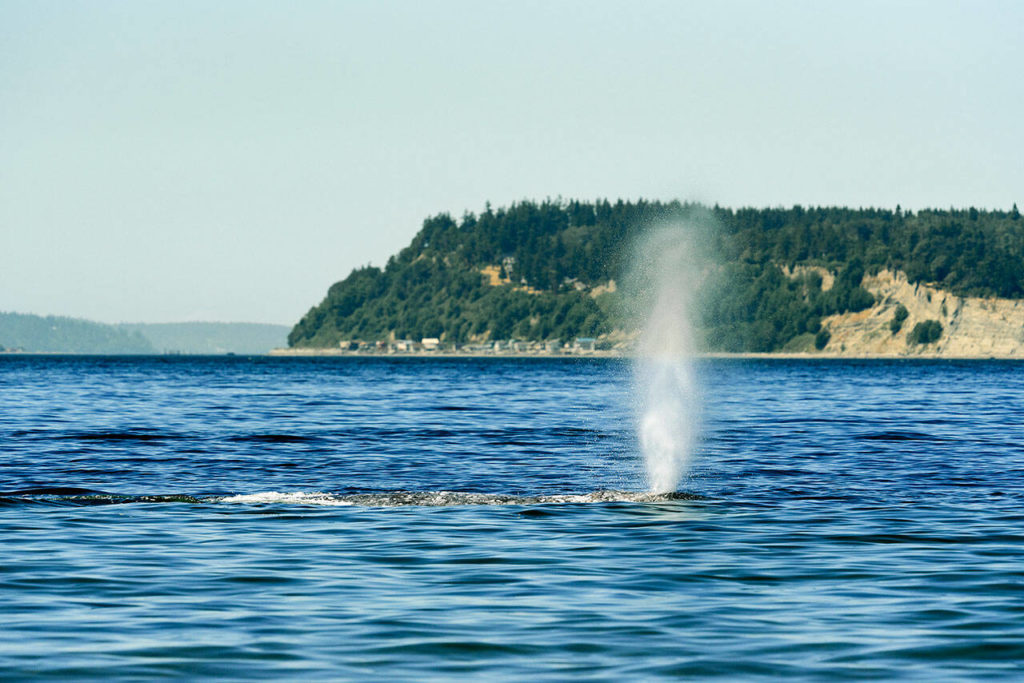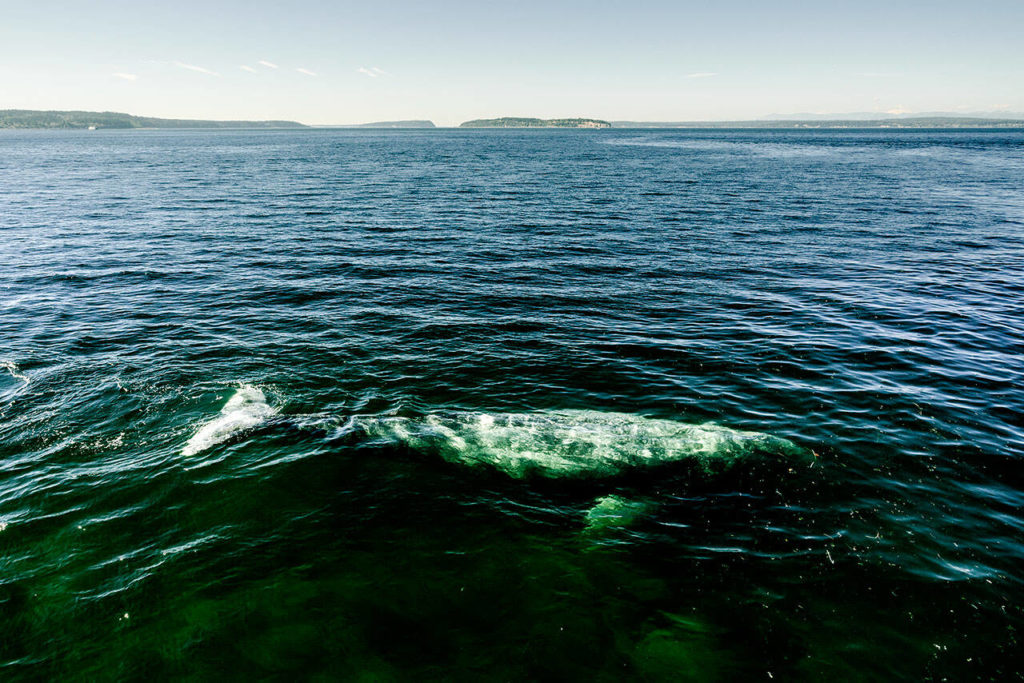MUKILTEO — A team called the Sounders rolls through the Salish Sea each year. They have no idea what a penalty kick is, but they have the endurance to swim over 10,000 miles annually.
The group of about 20 gray whales has taken a liking to intertidal waters in the northern Puget Sound. Year after year, scientists have seen the same whales make a stop in the area. They can be as long as 50 feet and weigh up to 45 tons.
One whale made the news last week when it was spotted off the Mukilteo Pier. It was the first time scientists had seen that particular gray show up in northern Puget Sound. Observers thought they saw two whales in the water, but scientists have only identified one, wildlife photographer Sara Montour Lewis said.
The gray, known to fans by nicknames such as “Joe Blowden” or “Krilla de Vil,” is formally named CR 2440. Scientists initially identified it in January off the coast of Victoria, British Columbia. The whale spent some time in the Rosario Strait before making its way south.
Earlier this week, CR 2440 was spotted in Holmes Harbor by Whidbey Island, Montour Lewis said.
“It’s a brand new dude. Or dudette,” she said. “We don’t know what its sex is yet. I think we are all asking ourselves, ‘When is this one going to leave?’ And then it just shows up somewhere else for a week at a time. It’s on its own timeline for sure.”
Months ago, scientists were worried about CRC 2440’s health.
“When it showed up in January, it was pretty thin,” Montour Lewis said. “A lot of them are pretty thin when they get here because they’ve been traveling and not eating. But I’m not worried about this whale anymore. It is clearly eating a lot and has kind of plumped up the past few months.”
In 1990, biologist John Calambokidis and his nonprofit Cascadia Research Collective began studying gray whales that annually visited the northern Puget Sound. Back then, there were only six grays in the group. As the group grew in size, scientists named them the Sounders.
Studying the Sounders has given Calambokidis and other scientists a fresh look into the world of gray whales. In the Salish Sea, they almost exclusively feed on ghost shrimp in the intertidal zone. When the tide is high, the whales swim close to shore in search of shrimp. That means their feeding grounds are exposed to the air at low tide. Scientists are able to document the quantity of ghost shrimp removed after a whale feeds.
“It provides a unique laboratory to document the feeding of gray whales in a way that isn’t possible, I think, with any other large whale population,” Calambokidis said. “We can measure the times they feed and the feeding pits they create. It provides a unique opportunity to look at something that hasn’t been possible with large baleen whales.”
The Cascadia Research website has an aerial map of feeding pits and graphs of population data collected over time.
In 2015, scientists began deploying what are called “multi-sensor suction-cup dive tags” to track the grays. The tags on the whales’ bodies collect video footage and other data from the enormous mammals as they swim around.
The Cascadia Research team installs the tags by boat, using a long pole-like device to attach the tag to the whale’s body.
“We sort of, I would call it, slap it on,” Calambokidis said.
The tags normally fall or are knocked off in a few hours or days. Using satellite trackers, the Cascadia team goes out to pick up the tags and analyze the data they collected.
‘A little bit rowdy’
Scientists were surprised by the amount of body-to-body contact that occurs between the grays.
“It seems to be more normal than we realized,” Calambokidis said. “Because it was happening a whole lot. … We’d see them swimming with each other, but we didn’t appreciate what they were doing under water.”
Some whales will swim to the bottom of the sound and lie on top of each other.
“There was some sexual behavior seen,” Calambokidis said, “though most of the Sounders are males. There is a minority of females. But gray whales are kind of known to be a little bit rowdy that way, if you will.”
The tag cameras have helped scientists to better understand how gray whales take note of “productive” feeding grounds, Calambokidis said. They return to those spots.
Gray whales tend to migrate from Mexico, where they breed, all the way to the Arctic and back each year. The Sounders have taught scientists that grays have less regimented migration than they once believed. The whales feed a lot during migration, Calambokidis said, often taking “major deviations” to seek out food in places such as Puget Sound.
Possession Sound seems to be a favorite hangout for the Sounders. Scientists believe this is due to the region’s high density of a favorite delicacy: ghost shrimp.
“Why and whether they might find some other areas that also meet that need — I’m not sure if there are other comparable areas they haven’t found yet,” Calambokidis said. “But they have certainly discovered this one.”
Typically, they arrive around late February and leave around early June. But whales such as CRC 2440 who arrive earlier and stay longer have been shaking up the status quo.
In the past few years, Calambokidis said, the North Pacific population has faced what scientists deemed an “unusual mortality event.” High numbers of gray whales have been washing up dead on coasts from Mexico to Alaska. In 2019, 30 grays washed up in Washington alone, well above the annual average of five or six washups the state usually sees.
“We think that unusual mortality rate was likely somewhat related to nutritional challenges they are facing in their primary feeding areas in the Arctic,” Calambokidis said.
Most of the Sounders seem healthy.
“We’ve had a very high survival rate of the gray whales that have engaged in this,” he said. “Even though they might initially be drawn here and adopt feeding in this area a little bit out of desperation and being in poor condition, it looks like it works out really well for them.”
Cascadia Research was tracking two of the original six Sounders until very recently. Both of them were first identified in 1991.
“One of them has stopped being seen,” Calambokidis said, “and we think it likely died. The other one looked like it was in pretty bad shape. It was last seen in April and we haven’t seen it since, so we’re worried about its fate as well.”
Calambokidis said that news was not unexpected given how long the whales had been around.
The mammals typically live from 55 to 70 years, according to American Oceans, an organization that promotes restoration, protection and preservation of coastal waters.
Newcomers have been arriving in the region, such as CR 2440. The whale won’t be considered a Sounder unless it returns in a future year.
‘A big splash’
Spring is the best time to spot the Sounders. CR 2440 is one of a small group of stragglers that haven’t already left the area for the year.
Scientists are asking people who want to spot grays to do so from the shore, a commercial whale watching boat or a ferry.
“What we try to discourage the most is for private boaters to find and approach whales,” Calambokidis said. “That would very rapidly crowd them.”
Scientists also urge people to give grays space.
“The rules for baleen whales is to stay 100 yards away,” said Montour Lewis, the photographer. “So yeah, maybe don’t swim to them.”
Be Whale Wise, a coalition dedicated to protecting marine life in Washington and British Columbia, has published a list of guidelines for people who see a whale in the wild. Private boaters are instructed to turn off their engines if a whale appears within 300 yards.
“It’s tricky because this ecosystem is here for all of us — for everybody — so it is a balance of keeping the whale safe and admiring it,” Montour Lewis said. “They are really good rules. I just think some private boaters aren’t aware of them. I think this isn’t about people having terrible intentions. They just don’t know the rules.”
Former Daily Herald reporter Zachariah Bryan was among the lucky ones who got a look at the newly minted celebrity gray during its weeklong visit to Everett.
Bryan, 33, who grew up in the Pacific Northwest, was on an afternoon walk last week at the Howarth Park beach when he saw CRC 2440 swim by. It was his first time spotting a whale in the wild.
“In that split second, I wondered if it was some kind of experimental vessel from the naval station,” he said. “I seriously thought this because my brain could not figure out what I was looking at. Then a big splash. I realized it was a whale. I nearly tripped over my girlfriend’s dog because I was so entranced.”
Ellen Dennis: 425-339-3486; ellen.dennis@heraldnet.com; Twitter: @reporterellen.
Talk to us
> Give us your news tips.
> Send us a letter to the editor.
> More Herald contact information.



























